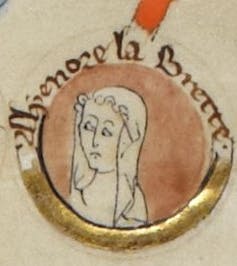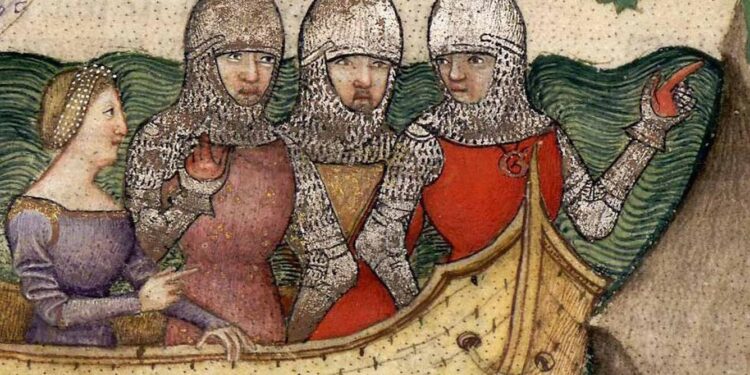Richard I being anointed during his coronation at Westminster Abbey in 1189, from 13th-century chronicle.
Chetham MS Ms 6712 (A.6.89), fol.141r
Freedom or control? The travels of the princess
A new chapter of the princess’s life began. She travelled with the two queens to Acre (in modern-day Israel), Rome, Pisa, Genoa, Marseilles, Aragon (on the Iberian Peninsula) and Poitou, in west-central France.
The historian Annette Parks has suggested that this offered an “odd kind of freedom” for the princess, travelling further than she ever had before and quite possibly crossing paths with the likes of the queen mother of England, Eleanor of Aquitaine. But despite her relative “freedom” in accompanying the two queens, these travels were not at the princess’s own discretion, and her movements were controlled.
After Richard’s own capture by the Holy Roman Emperor, the agreement for his release included his consenting to the marriage of both the princess and Eleanor of Brittany (who was also in Richard’s custody) to the sons of Leopold V of Austria.

Looking for something good? Cut through the noise with a carefully curated selection of the latest releases, live events and exhibitions, straight to your inbox every fortnight, on Fridays. Sign up here.

Eleanor of Brittany circa 1300.
British Library/Royal MS 14 B V
The two women began to travel to Austria together in 1193 only to turn around part way through the journey, as the death of Leopold brought an end to the agreement. The princess may then have accompanied Joanna of Sicily during her second marriage to Raymond VI of Toulouse in 1196.
With Richard’s death in 1199, the princess was finally freed and went on to make two advantageous marriages. First, to Raymond VI, the same man who had been married to Joanna of Sicily until her death also in 1199. Second, to Thierry of Flanders after the annulment of her first marriage. Raymond had repudiated the princess in favour of a stronger marriage alliance with Leonor, the daughter of Alfonso II of Aragon.
It was during this second marriage that the princess briefly becomes visible in the historical record again.
In 1204 Thierry attempted to reclaim Cyprus through the rights of his wife. By this point, the political circumstances of Cyprus had changed and a new king had been installed. Thierry and the princess’s attempt was unsuccessful and the two were forced to flee, after which they disappear from the record for good.
The Damsel of Cyprus had almost no control over her life. But the record shows instances in which her own strength and tenacity were able to shine through. From facing King Richard in surrender, to forming advantageous marriages when she had no networks of her own, she navigated the circumstances that captivity brought upon her and she found ways to survive and retain her status as an elite woman. I would even speculate that the attempt to reclaim Cyprus was at the princess’s instigation, in an effort to regain her home.
As a young girl with no say over much of her life, the Damsel of Cyprus is a reminder of how medieval women continued to find ways to overcome the limitations placed on them.
Source link : http://www.bing.com/news/apiclick.aspx?ref=FexRss&aid=&tid=677c02a5d96740f09d1e2605882b5b7f&url=https%3A%2F%2Ftheconversation.com%2Fpirates-princes-and-hostages-inside-the-mysterious-life-of-the-unnamed-medieval-princess-of-cyprus-244966&c=10627957607684595788&mkt=de-de
Author :
Publish date : 2025-01-06 05:18:00
Copyright for syndicated content belongs to the linked Source.



